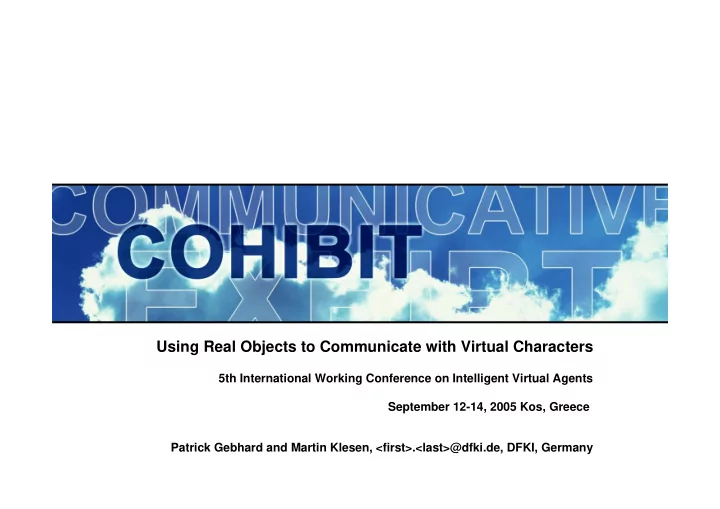

Using Real Objects to Communicate with Virtual Characters 5th International Working Conference on Intelligent Virtual Agents September 12-14, 2005 Kos, Greece Patrick Gebhard and Martin Klesen, <first>.<last>@dfki.de, DFKI, Germany
Outline • Installation • Creation – challenges – domain and context – event management • Authoring • Interaction Design • Summary and Future Work IVA05 2/18 Patrick Gebhard, Martin Klesen
Installation • Automobile theme park environment • Tangible exploration experience – 3D car puzzle – 10 RFID equipped car pieces • Life-size virtual characters – comment user activities – help and motivate – guides, commentators, experts, motivators, tutors • Co mmunicative Ex hibit IVA05 3/18 Patrick Gebhard, Martin Klesen
Technical Setup large back-projection virtual projection screen car pieces construction table with workbench IVA05 4/18 Patrick Gebhard, Martin Klesen
Technical Setup (cont.) cameras for user detection IVA05 5/18 Patrick Gebhard, Martin Klesen
In Action – The Three Phases IVA05 6/18 Patrick Gebhard, Martin Klesen
Challenges • Robustness • Different interaction styles – kids and adults – single and multi user – action-focused vs. character-focused • Overall: it has to be fun! • Flexible authoring process – Extentions (content) – Redesign (interaction behavior) IVA05 7/18 Patrick Gebhard, Martin Klesen
Creation Process • Domain modeling and context classification – car configurations – construction states • Event management – recognizing users’ actions • Interaction modeling – SceneMaker * – sceneflow (narrative structure, hierarchical FSMs) – scenes (content, screen-play like language) * Gebhard et al. Authoring Scenes for Adaptive, Interactive Performances In: Proceedings of the Second International Joint Conference on Autonomous Agents and Multiagent Systems (AAMAS-03), Melburne, 2003. IVA05 8/18 Patrick Gebhard, Martin Klesen
Car Configurations • 10 car elements, 5 workbench positions • 802.370 combinations! • Construction code F, C, M, R, # (e.g. FCR, FC#R) • Construction orientation – determined by majority of elements pointing in same direction – can change! IVA05 9/18 Patrick Gebhard, Martin Klesen
Construction State • Evaluation of local context – reduces complexity – e.g. FR# • Five major states – car completed, e.g. FCMMR (30) – valid construction, e.g. FCM (8040) – invalid configuration, e.g. RC – completion impossible, e.g. CM at the left side – wrong direction, e.g. FCMR IVA05 10/18 Patrick Gebhard, Martin Klesen
Event processing • Two phases 1. visitors’ actions ➙ transition events (event rules) ➙ updating domain model 2. classification • Top-level transition events 1. visitor appeared, visitor disappeared 2. car completed, car disassembled 3. piece taken, piece placed 4. piece uphold • Transition events for sceneflow branching IVA05 11/18 Patrick Gebhard, Martin Klesen
Authoring • SceneflowEditor – faster creation and redesign – “safer” authoring – visualization of narrative structure • Scenes – multiple topic histories – template-based (using context queries) – variability through alternative turns IVA05 12/18 Patrick Gebhard, Martin Klesen
SceneflowEditor selected supernode drag&drop elements scenes commands IVA05 13/18 Patrick Gebhard, Martin Klesen
Scenes context commands alternative turns emotions gestures overlay gestures system commands scene topic IVA05 14/18 Patrick Gebhard, Martin Klesen
Interaction Design • Iterative process based on user observations • 15 naïve visitors at 2 development stages • Balance continuity and reactivity ➙ – user action focused erratic behavior ➙ – information focused dull behavior • Believable dialog behavior and variance – handling interruptions – motivation of users IVA05 15/18 Patrick Gebhard, Martin Klesen
Motivation of users • Initial: sequential – >8sec help, >20sec calm user, >30sec smalltalk • Observation – motivation is appreciated – comments often too late – simple dialog pattern lowers believability • Current: hybrid – context based – random branching IVA05 16/18 Patrick Gebhard, Martin Klesen
Handling Interruptions • Initial: hard interruption – events directly interrupt on-going conversation • Observations – mechanical behavior – confusing abrupt topic changes • Current: smooth interruption – making some scenes uninterruptible – providing transition scenes IVA05 17/18 Patrick Gebhard, Martin Klesen
Summary and Future Work • Scripted interactive installation with virtual characters • SceneMaker with SceneflowEditor enables flexible fast design and redesign workflow • Facts: 2 months, 7 people: 375 scenes, 1 sceneflow with 82 nodes and 114 transitions • Future: more automation! – gesture generator – dialog act generator IVA05 18/18 Patrick Gebhard, Martin Klesen
Recommend
More recommend